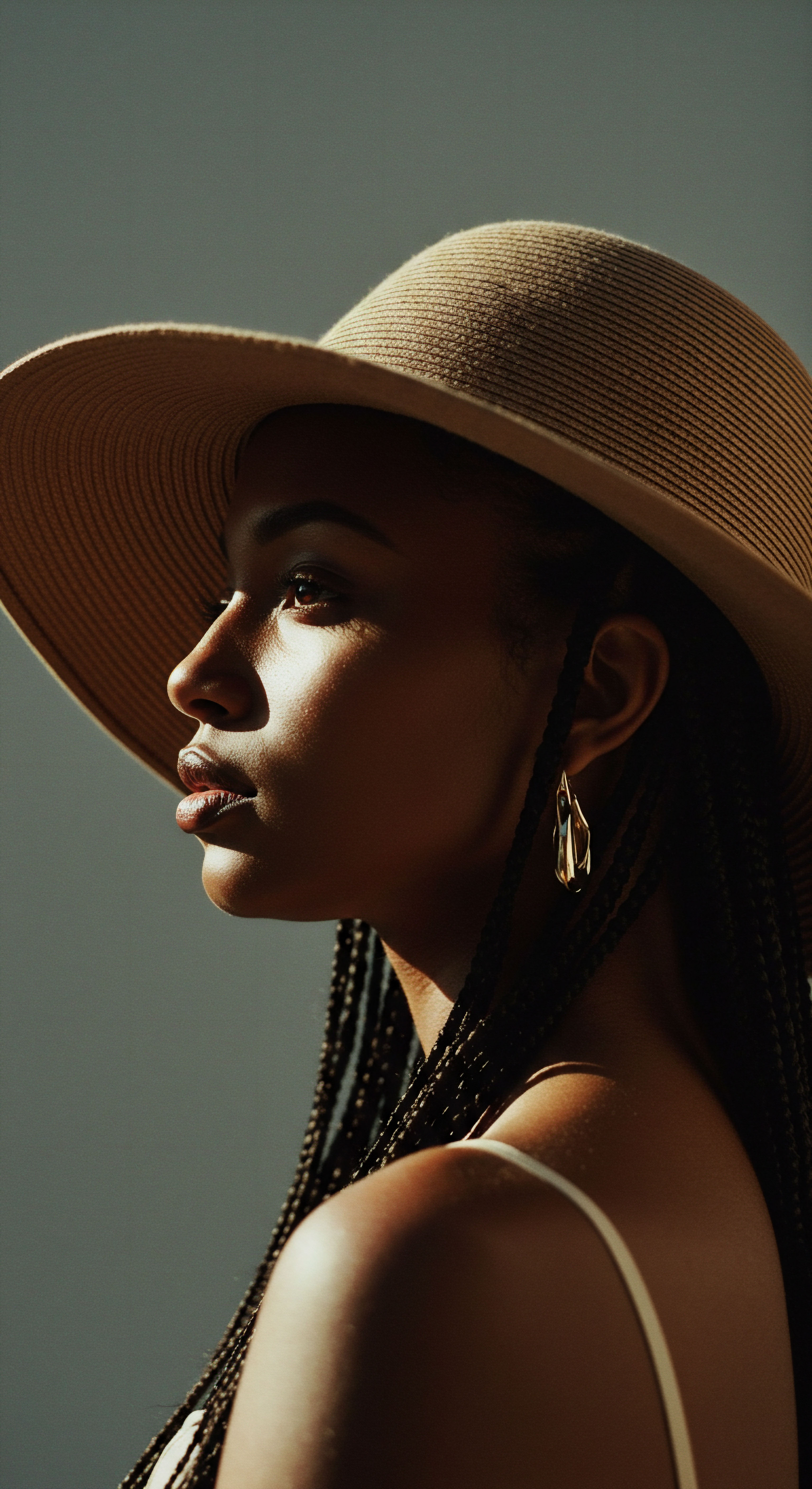
Roots
Within the realm of hair care, where so much focus falls upon the visible strands, a deeper truth often awaits recognition ❉ the scalp, that quiet, living expanse beneath our hair, serves as the very foundation of its vitality. This often-overlooked skin plays a complex, protective role, acting as a delicate ecosystem. When we consider practices like wearing bonnets, our attention must naturally extend beyond merely shielding our hair to how these coverings interact with the scalp itself. The conversation around whether bonnet fabrics contribute to scalp irritation begins here, at the elemental level of skin physiology and material science.
The skin covering our heads possesses unique characteristics. It boasts a higher density of sebaceous glands compared to other body areas, producing sebum that coats both the scalp and hair, forming a protective barrier. This natural lipid layer, along with the stratum corneum, the outermost layer of the skin, works diligently to guard against external aggressors and regulate moisture.
Disruptions to this finely tuned system can invite discomfort and concern. Understanding the fundamental interaction between various materials and this sensitive skin is paramount to nurturing hair health from its true source.

Scalp Anatomy and Protective Layers
Our scalp is a complex structure, far more than just a surface for hair to grow. It comprises several layers, with the outermost, the Epidermis, providing the primary defense. Within the epidermis, the stratum corneum functions as a robust barrier, a shield against environmental factors and microbial invasion.
Beneath this lies the dermis, rich in blood vessels, nerves, and hair follicles, all working in concert to sustain hair growth. A healthy scalp is a testament to the effective operation of these intricate biological systems.
The scalp’s natural defenses also rely on its unique microbial inhabitants, a community of bacteria and fungi living in balance. This Scalp Microbiome, much like the gut microbiome, plays a significant role in maintaining skin health. When this delicate balance is disturbed, certain microorganisms, such as those from the Malassezia genus, can overgrow, leading to conditions like dandruff or seborrheic dermatitis. Any external influence, including the choice of bonnet fabric, has the potential to alter this microbial landscape, prompting questions about its effects on skin harmony.
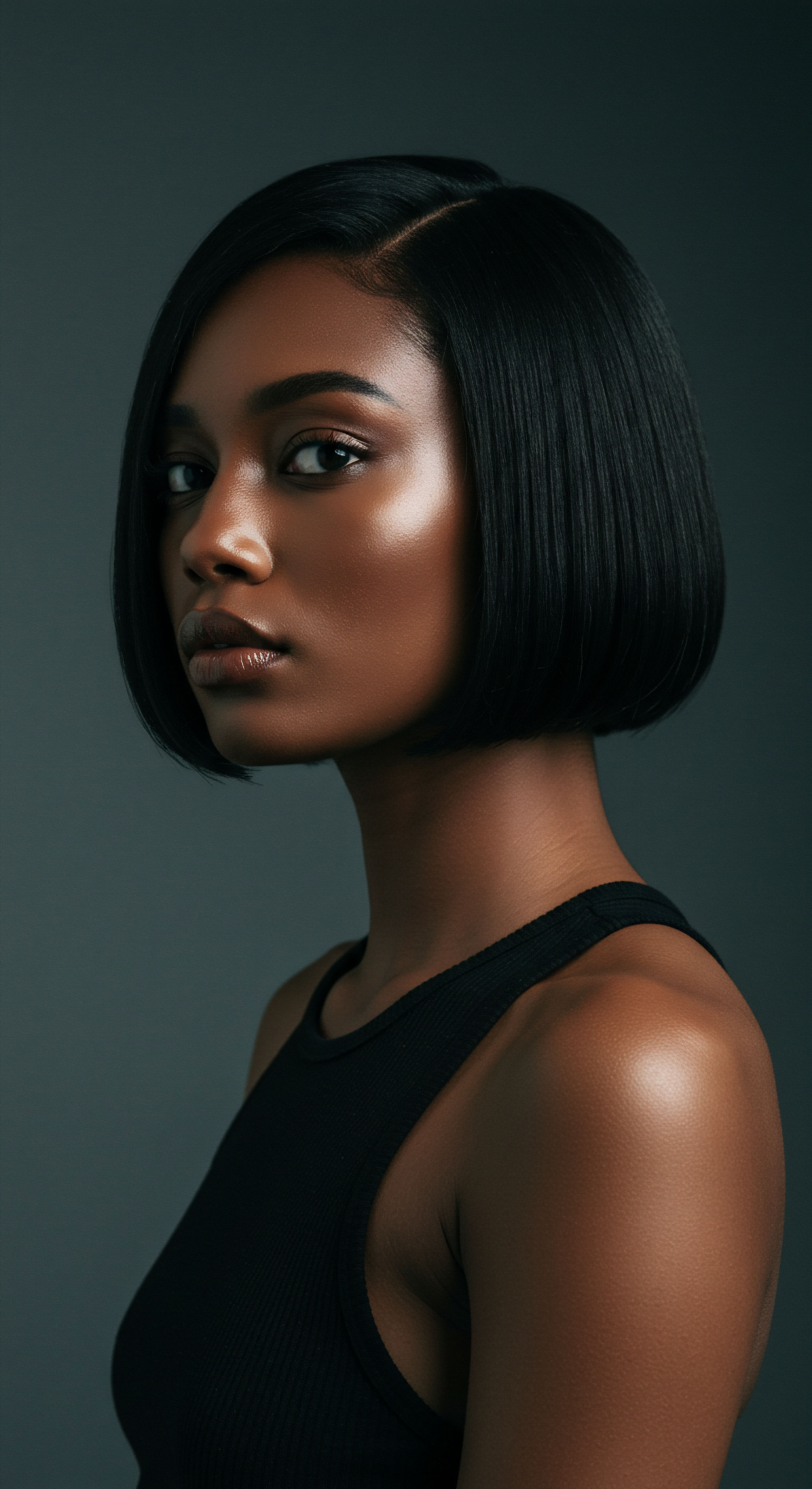
How Do Fabrics Meet the Scalp?
The interaction between bonnet fabrics and the scalp is not a simple touch; it is a dynamic exchange influenced by material properties, moisture, and temperature. Different fibers possess distinct qualities that determine how they behave against skin. Cotton, a natural fiber, is highly absorbent, readily drawing moisture from the hair and scalp. While this might seem beneficial in some contexts, for the scalp, it can lead to dryness.
Silk, also a natural protein fiber, and satin, often a synthetic polyester weave designed to mimic silk’s smoothness, exhibit lower absorbency and create less friction. These differences become particularly meaningful during prolonged contact, such as overnight wear.
The choice of material can directly influence the scalp’s microclimate. A bonnet creates a confined space around the head, potentially altering temperature and humidity levels. For instance, less breathable fabrics might trap heat and moisture, creating a warm, damp environment.
Such conditions, while seemingly innocuous, can impact the scalp’s natural pH and promote the proliferation of certain microorganisms, tipping the delicate microbial balance. This environmental shift forms a direct link to potential irritation.
The scalp, a living ecosystem, finds its delicate balance influenced by the intimate contact with bonnet fabrics, where material properties dictate the microclimate.
Consider the tactile experience of various materials. The microscopic surface of cotton fibers can be somewhat abrasive, potentially causing minor friction against the sensitive skin of the scalp. Silk and satin, known for their smooth surfaces, reduce this mechanical friction, allowing hair and skin to glide more freely. This reduction in physical drag is not merely a matter of comfort; it has tangible implications for the integrity of hair strands and the potential for scalp irritation.
| Fabric Type Silk |
| Primary Composition Natural Protein Fibers |
| Moisture Absorption Low (around 11%) |
| Friction Coefficient Very Low (0.7-1.2µ) |
| Breathability Good |
| Fabric Type Satin (Polyester) |
| Primary Composition Synthetic (e.g. Polyester) |
| Moisture Absorption Low |
| Friction Coefficient Low |
| Breathability Moderate to Low |
| Fabric Type Cotton |
| Primary Composition Natural Cellulose Fibers |
| Moisture Absorption High (up to 25%) |
| Friction Coefficient Higher (4-5µ) |
| Breathability Good |
| Fabric Type These properties collectively determine a fabric's interaction with the scalp environment. |
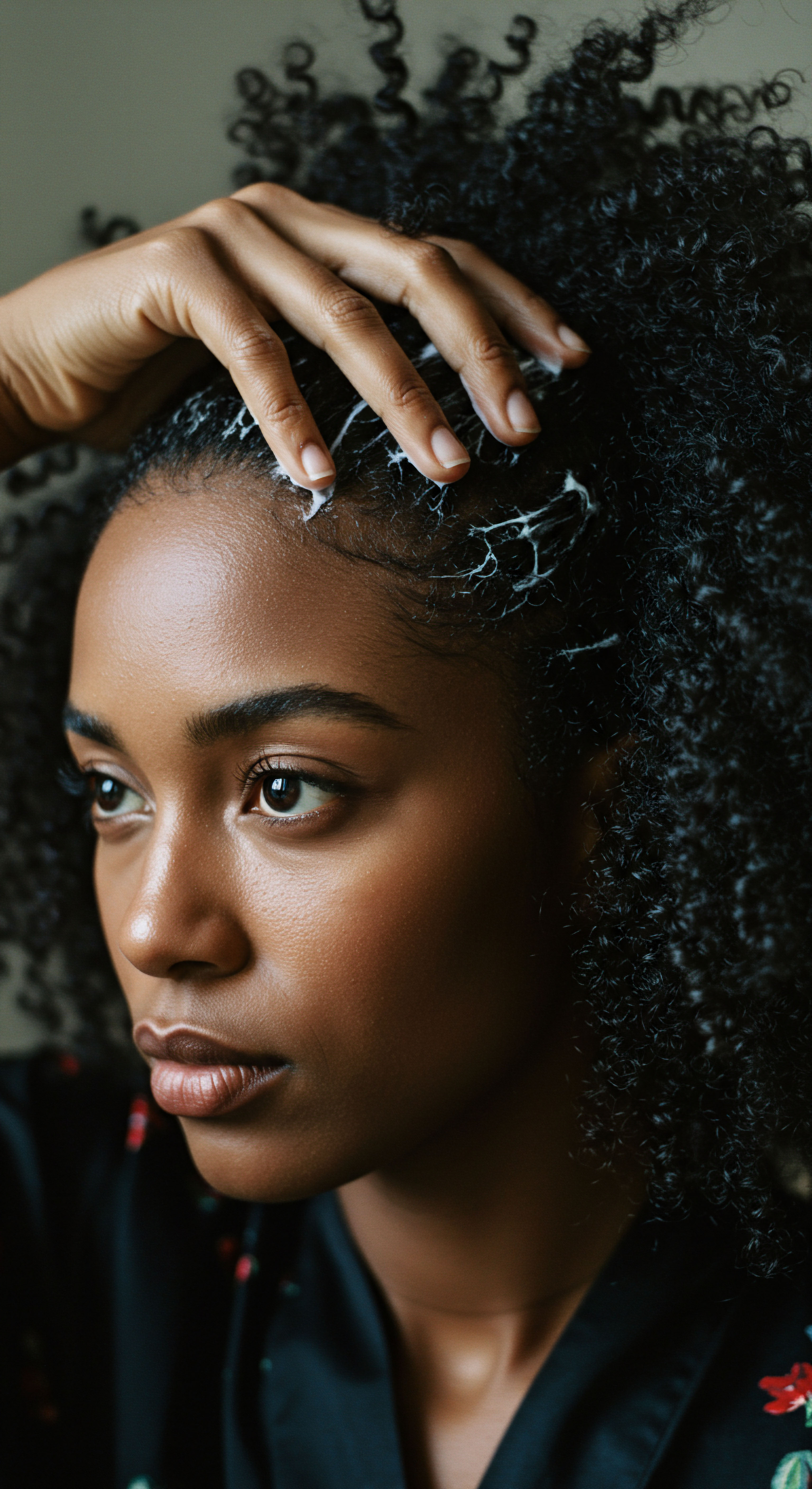
Why Does Scalp Sensitivity Vary?
Individual responses to bonnet fabrics are not uniform, reflecting the unique sensitivities of each person’s scalp. Some individuals possess a naturally more reactive skin barrier, making them more prone to irritation from various external stimuli. This predisposition can stem from genetic factors, existing skin conditions like eczema or psoriasis, or even the general health of their skin barrier. A scalp with impaired barrier function, perhaps due to dryness or minor abrasions, may react more intensely to friction or moisture changes.
Furthermore, the sensory nerve density in the scalp, while present, can be less acute than other areas of the skin, meaning irritation might progress unnoticed until it reaches a more pronounced stage. This characteristic of the scalp, having a lower stratum corneum function yet less sensitive sensory nerves, suggests that problems might worsen before symptoms become undeniable. This subtle nature of scalp feedback means paying close attention to any shifts in comfort or appearance becomes even more important.
- Skin Barrier Health ❉ A compromised skin barrier allows irritants to penetrate more readily.
- Existing Conditions ❉ Individuals with eczema, psoriasis, or seborrheic dermatitis may have heightened reactivity.
- Microbiome Balance ❉ An imbalance in the scalp’s microbial community can predispose to irritation.
The journey to understanding bonnet fabrics and scalp irritation truly begins by recognizing the scalp as a vibrant, living entity, susceptible to its environment. Its intricate structure, delicate microbial balance, and individual sensitivities all play a part in how it responds to the materials we choose for our hair coverings. With this foundational knowledge, we can approach the practicalities of care with greater awareness and intention.
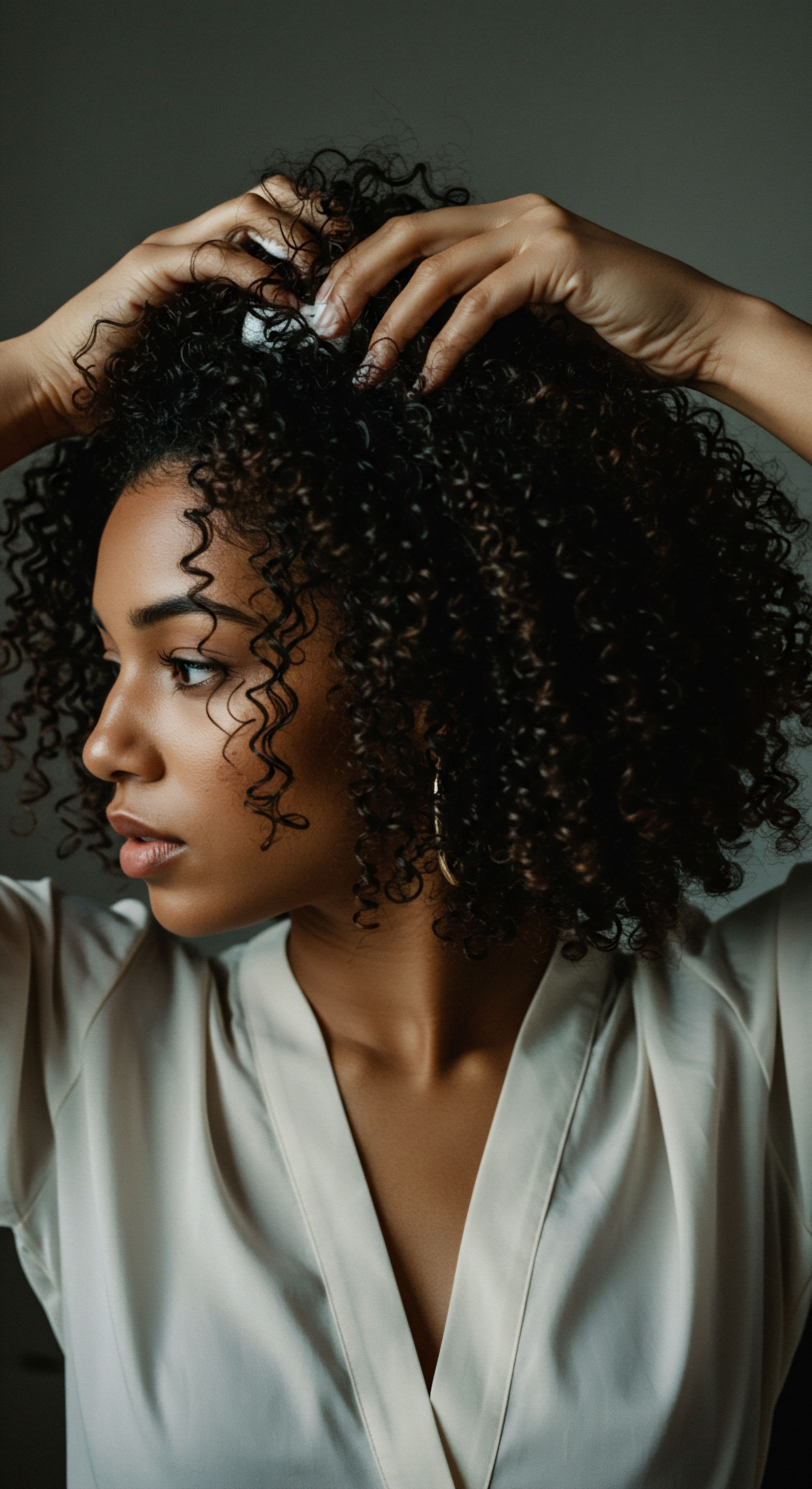
Ritual
As we move from the elemental understanding of our scalp to the practicalities of daily life, the choice to cover our hair, particularly overnight, enters the realm of ritual. For many, a bonnet is more than a simple accessory; it is a silent partner in the nightly routine, a guardian of curls, coils, and delicate strands. The intention behind wearing a bonnet is often protective, aimed at preserving style, retaining moisture, and minimizing friction against pillowcases.
Yet, even within this beneficial practice, questions arise regarding its interaction with the scalp. This section looks at the common ways bonnets are used and how these habits can either soothe or disturb the scalp’s delicate balance.
The historical context of head coverings, stretching back through generations and across cultures, speaks to a deeply ingrained practice of hair preservation and identity. From ancient Egyptian linens shielding against the sun to elaborate African headwraps signifying social status and resilience, the act of covering hair holds profound meaning. Modern bonnets carry echoes of this heritage, serving as a practical tool for maintaining textured hair, which is often more prone to dryness and breakage. The wisdom passed down through families, now often reinforced by contemporary hair science, guides many in adopting this nighttime practice.

Why Do We Choose Bonnets?
The primary motivations for donning a bonnet are often clear ❉ to reduce physical damage, preserve moisture, and extend the life of hairstyles. Textured hair, with its unique structure, is particularly susceptible to friction damage from rough fabrics like cotton pillowcases. This friction can lead to raised cuticles, breakage, and frizz.
Bonnets, especially those made from smoother materials, act as a buffer, allowing hair to glide rather than snag. This protective shield helps maintain the integrity of the hair shaft.
- Friction Reduction ❉ Smooth fabrics significantly lessen rubbing against hair strands.
- Moisture Preservation ❉ Bonnets help retain the hair’s natural oils and applied products.
- Style Extension ❉ They protect hairstyles from being flattened or disturbed during sleep.
Beyond these practical benefits, bonnets contribute to a sense of order and care within a personal beauty regimen. The simple act of placing a bonnet upon the head signals a transition to rest, a commitment to preserving the hair’s condition. For many, this ritual is intertwined with self-care, a quiet moment of attention to one’s well-being.
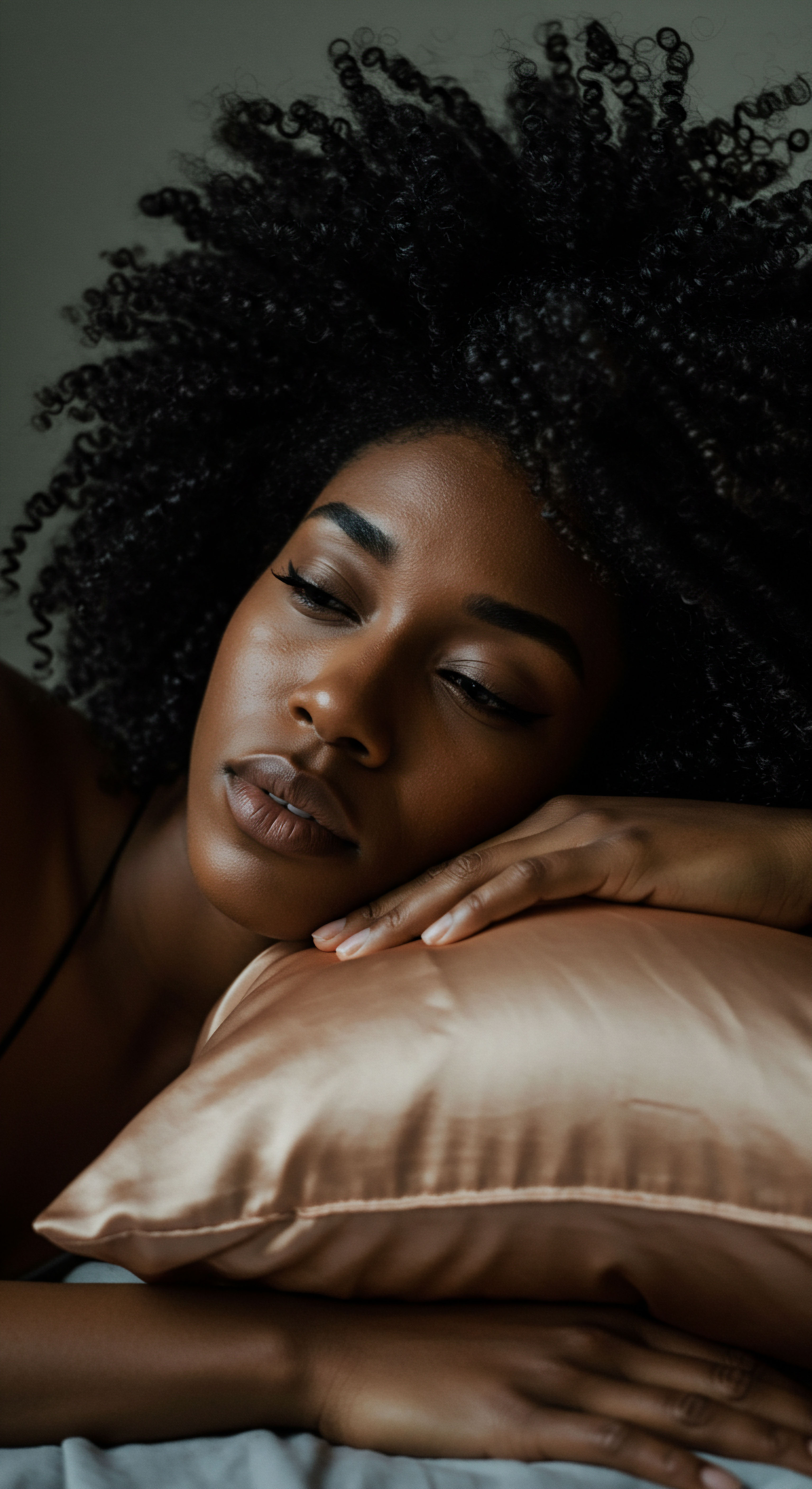
Can Wearing a Bonnet Too Tight Cause Scalp Issues?
While bonnets offer many advantages, their application demands consideration. A bonnet that fits too snugly, particularly around the hairline or nape, can exert constant pressure on the hair follicles. This sustained tension can lead to a condition known as Traction Alopecia, a form of hair loss caused by repetitive pulling on the hair.
The scalp, in these areas, may also experience increased friction and reduced air circulation, leading to irritation, redness, or even tenderness. This physical stress, rather than the fabric itself, becomes the source of concern.
The delicate skin around the hairline is especially vulnerable. Consistent pulling can compromise the follicular structures, making them more susceptible to inflammation and weakening the hair’s attachment. Over time, if left unaddressed, this can result in noticeable hair thinning or loss along the edges. This issue is particularly relevant for individuals with textured hair, as their hair follicles may have fewer elastic fibers attaching them to the dermis, making them more prone to traction-induced damage.
Proper bonnet fit is essential, as excessive tightness can strain hair follicles, potentially leading to traction alopecia and scalp irritation.

Is Wet Hair Under a Bonnet Problematic?
The question of placing wet or damp hair beneath a bonnet often arises. While the intention might be to seal in moisture, this practice can inadvertently create an environment ripe for microbial overgrowth. A warm, humid space, especially one lacking adequate air circulation, becomes an ideal breeding ground for bacteria and fungi. This elevated moisture and temperature can disrupt the scalp’s natural pH and encourage the proliferation of organisms like Malassezia, contributing to itching, flaking, or even scalp infections.
Furthermore, wet hair is more fragile and susceptible to mechanical damage. When damp hair rubs against the bonnet fabric, even smooth ones, the potential for breakage increases. The hair shaft, swollen with water, is more elastic but also more vulnerable to the shearing forces of friction. Allowing hair to air dry or using a gentle, low-heat dryer before bonnet application can significantly mitigate these risks, preserving both hair integrity and scalp health.
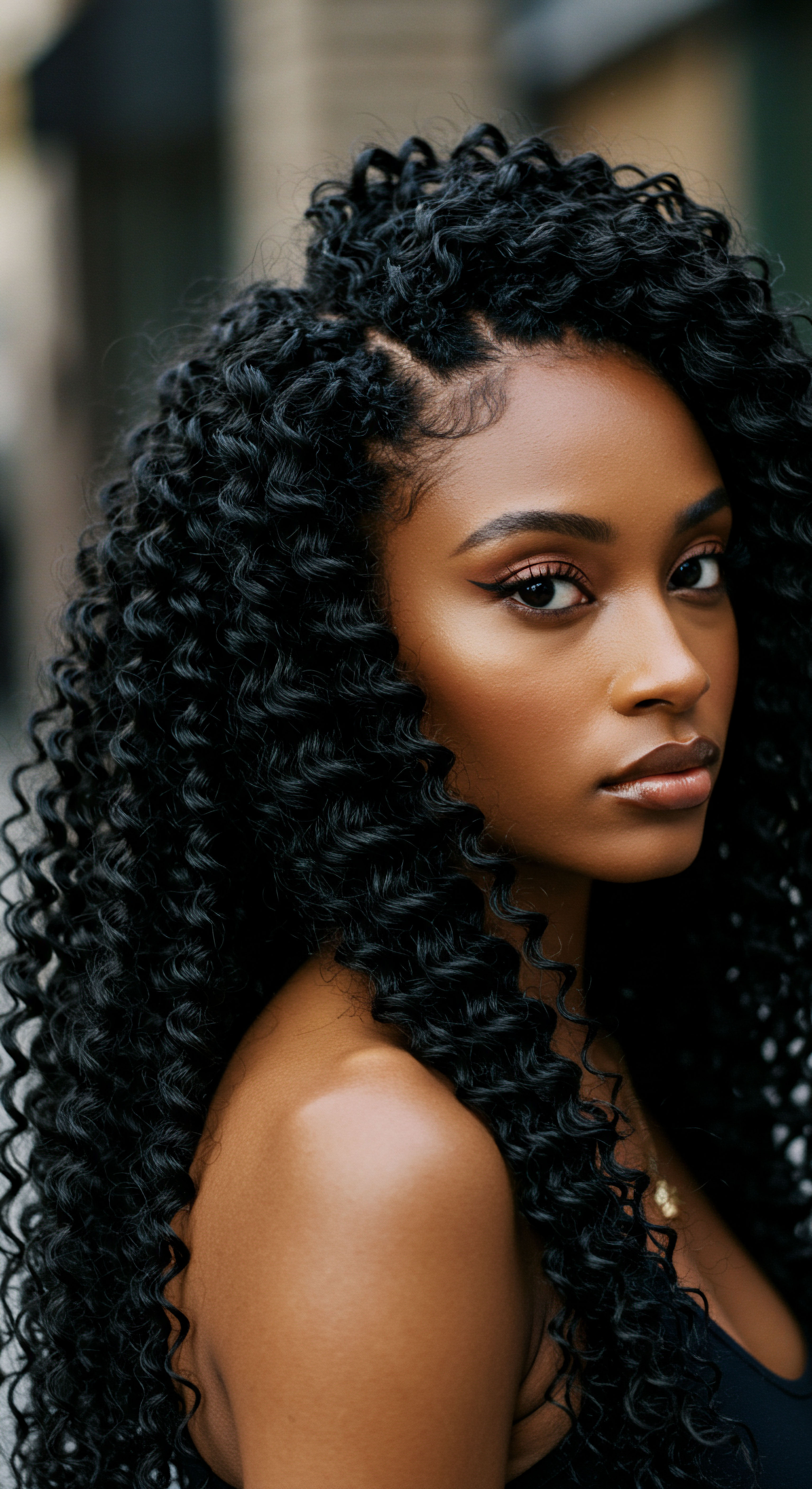
Selecting the Right Bonnet and Maintaining It
The conscious choice of bonnet material and consistent care are central to avoiding scalp irritation. Silk and satin are widely favored for their smooth surfaces, which reduce friction and help retain moisture. Studies suggest silk can reduce hair breakage by as much as 43% compared to cotton alternatives, highlighting its gentler nature. Bamboo is another option gaining recognition for its softness, breathability, and hypoallergenic qualities.
Equally important is the routine cleaning of bonnets. Like any textile in close contact with skin, bonnets can accumulate natural oils, product residue, and environmental debris. Infrequent washing can lead to a buildup that irritates the scalp or contributes to microbial imbalances. Regular, gentle cleansing ensures the bonnet remains a hygienic protective layer, rather than a source of potential problems.
When choosing a bonnet, consider the following aspects ❉
- Material ❉ Opt for Silk or Satin for minimal friction and moisture preservation.
- Fit ❉ Ensure the bonnet is snug enough to stay on but not so tight that it creates tension or leaves marks.
- Breathability ❉ Look for fabrics that allow some air circulation, especially if you tend to sweat at night.
- Cleanliness ❉ Wash your bonnet regularly with a gentle, hypoallergenic cleanser to prevent product buildup and bacterial growth.
- Dampness ❉ Avoid placing bonnets over hair that is still wet; ensure hair is at least damp or completely dry.
The nightly ritual of bonnet wearing, when approached with awareness and informed choices, truly becomes a gesture of profound care. It transforms a simple covering into a tool for sustaining hair health and scalp comfort, honoring both ancestral wisdom and modern understanding.

Relay
Beyond the daily rhythms of hair care, the question of bonnet fabrics and scalp irritation invites a deeper, more analytical examination. This exploration requires us to consider not just the obvious friction or tension, but the subtle biological and chemical interactions that unfold between textile and skin. We move into the realm where scientific inquiry meets lived experience, seeking to understand the intricate mechanisms that can transform a protective accessory into a source of discomfort. This requires us to piece together insights from dermatology, microbiology, and textile science, creating a comprehensive picture of scalp well-being.

Can Bonnet Fabrics Alter Scalp Microclimate and Microbiome?
The environment created by a bonnet, particularly during extended wear, can significantly alter the scalp’s microclimate. This enclosed space can lead to increased temperature and humidity, a phenomenon known as Occlusion. While occlusion is sometimes therapeutically applied in dermatology to enhance topical medication absorption, its unintended consequence on healthy skin can be a shift in the scalp’s delicate ecosystem. Research indicates that occlusion can raise the skin’s pH, making it more alkaline, and potentially increase transepidermal water loss (TEWL) after removal, compromising the skin barrier.
A key consequence of altered scalp conditions is its influence on the Scalp Microbiome. The balance of microorganisms living on our scalp is finely tuned. When humidity and temperature rise under occlusion, it can favor the overgrowth of certain species, notably lipophilic yeasts like Malassezia. These yeasts, while naturally present, can become problematic in excessive numbers, contributing to scalp conditions such as seborrheic dermatitis and dandruff.
They break down sebum into irritating free fatty acids, triggering inflammation and itching. A study in Jakarta found that among hijab-wearing women, scalp itching (59.4%) and dandruff (56.3%) were frequently reported concerns, suggesting a correlation between prolonged head covering and these conditions, likely mediated by changes in the scalp environment. This correlation highlights the sensitivity of the scalp’s microbial balance to its immediate surroundings.
The prolonged moist environment can also create conditions for bacterial proliferation, potentially leading to folliculitis or other minor infections, especially if the scalp barrier is already compromised by scratching or pre-existing conditions. The warmth and moisture under a bonnet, combined with the presence of skin cells and sebum, offer a nutrient-rich environment for opportunistic microorganisms.
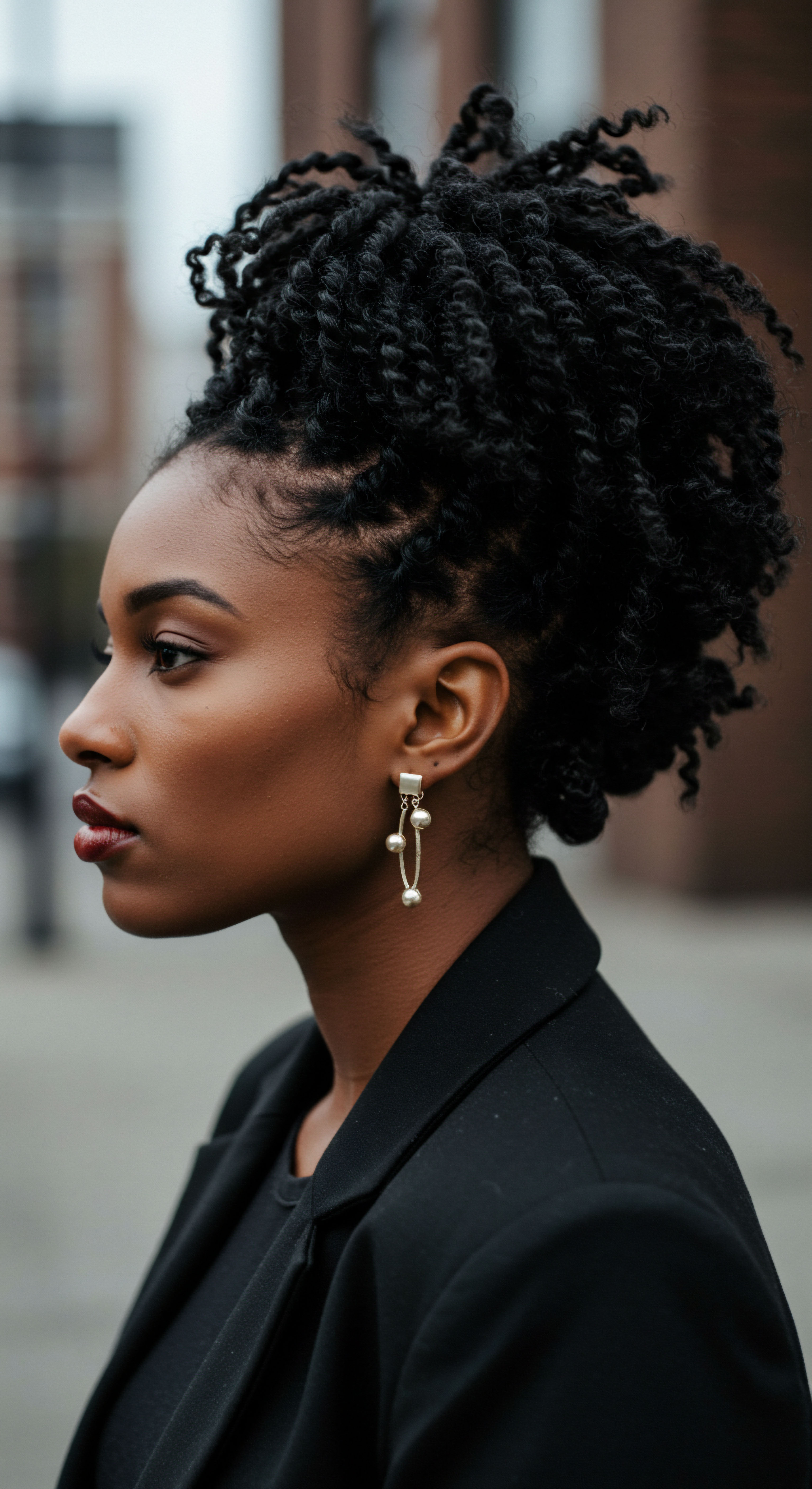
Do Chemical Residues in Fabrics Cause Irritation?
Beyond the physical properties of the fibers themselves, the chemical treatments applied to fabrics during manufacturing present another potential source of scalp irritation. Textiles often undergo processes involving dyes, formaldehyde finishing resins, glues, and various chemical additives to achieve desired textures, colors, and durability. For individuals with sensitivities or allergies, these residues can trigger Allergic Contact Dermatitis.
Symptoms can range from mild irritation, such as redness, itching, or a burning sensation, to more severe reactions like blistering or swelling. One prominent allergen is paraphenylenediamine (PPD), commonly found in darker hair dyes but also used in some textile dyes. A case report described a patient experiencing scalp dermatitis consistent with contact allergy to PPD, initially sensitized by a temporary tattoo, which then cross-reacted with textile dyes.
This demonstrates how sensitivities to seemingly unrelated chemical exposures can manifest as scalp irritation from fabric contact. Even “100% organic cotton” or “OEKO-TEX” certified fabrics, while less likely to contain allergenic dyes and formaldehyde resins, still warrant attention for individual reactions.
This aspect of irritation is often overlooked, as the focus typically remains on the fabric’s feel. However, the unseen chemical footprint of textiles can play a significant role in scalp discomfort, requiring careful consideration of sourcing and washing practices.
| Irritant Category Mechanical Friction |
| Examples Rough fabric surfaces (e.g. certain cotton weaves), tight elastic bands |
| Mechanism of Irritation Abrasion of scalp skin, physical stress on hair follicles, leading to inflammation or breakage. |
| Irritant Category Occlusion Effects |
| Examples Less breathable fabrics (e.g. some polyesters, very thick materials) |
| Mechanism of Irritation Traps heat and moisture, alters scalp pH, promotes microbial overgrowth (Malassezia, bacteria). |
| Irritant Category Chemical Residues |
| Examples Dyes (e.g. PPD), formaldehyde resins, finishing agents |
| Mechanism of Irritation Trigger allergic contact dermatitis in sensitized individuals, causing redness, itching, blistering. |
| Tightness/Tension |
| Snug elastic, improper bonnet sizing, tight hairstyles underneath |
| Constant pulling on hair roots, leading to traction alopecia, follicular inflammation. |
| Irritant Category Understanding these diverse mechanisms allows for a more targeted approach to preventing scalp irritation. |
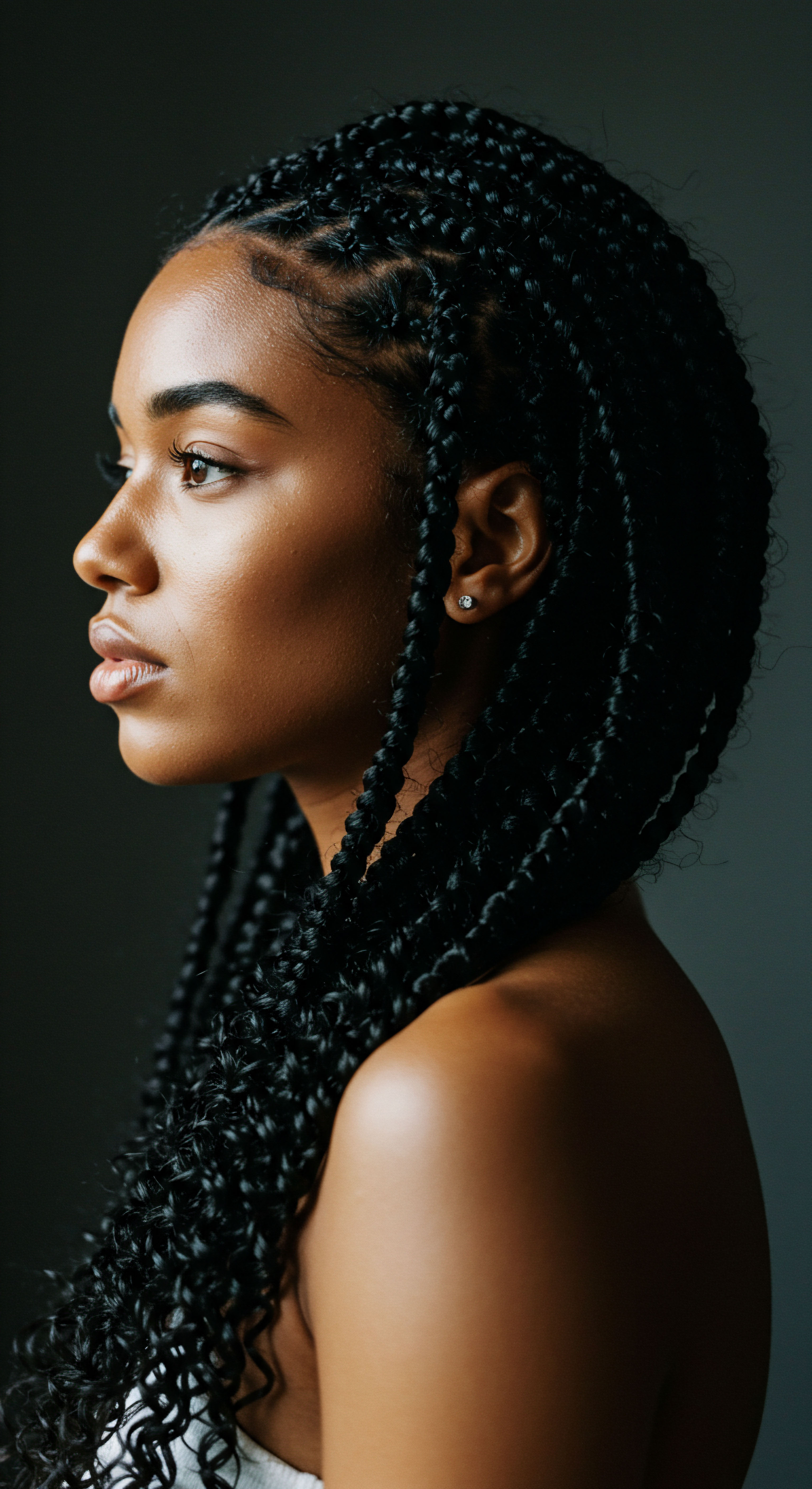
Does Fabric Friction Cause Scalp Damage?
The continuous, subtle rubbing between hair, scalp, and bonnet fabric can indeed contribute to irritation and damage over time. While silk and satin are lauded for their smooth surfaces, which reduce friction compared to cotton, the sheer duration of overnight contact still presents a mechanical challenge. This is particularly relevant for individuals with delicate or compromised scalps.
Studies have shown that silk bonnets can reduce hair breakage by 43% compared to cotton alternatives, underscoring the impact of friction on hair integrity. This principle extends to the scalp, where constant abrasion, even at a microscopic level, can disrupt the stratum corneum, making it more vulnerable to external factors.
For some, this friction manifests as subtle itching or a feeling of dryness, a response from the skin’s barrier attempting to cope with continuous mechanical stress. Over time, this can exacerbate existing sensitivities or even induce new ones. The type of fiber, its weave, and the presence of any stiff or frayed areas can all influence the degree of friction experienced. Even bonnets designed to be gentle can cause localized pressure or rubbing if not fitted correctly or if hair is styled in a way that creates tension points.
Beyond mere discomfort, prolonged fabric contact can physically compromise the scalp’s protective barrier, inviting further irritation.

How Do Head Coverings Affect Hair Loss Patterns?
The relationship between head coverings and hair loss is a topic of ongoing discussion, particularly concerning conditions like Traction Alopecia. This form of hair loss results from repetitive or prolonged pulling on the hair follicles. While bonnets are often worn to protect hair, a bonnet that is too tight, or elastic bands that are too restrictive, can inadvertently contribute to this condition. The hairline, temples, and nape are particularly susceptible, as these areas often bear the brunt of the tension.
Research highlights that certain styling practices underneath head coverings, such as tightly pulled ponytails or braids, can compound the issue, increasing the strain on hair roots. This is a significant consideration for individuals with textured hair, as their hair’s inherent curl pattern and follicle structure can make them more vulnerable to traction-induced damage. While the bonnet fabric itself does not directly cause this type of hair loss, its tight application, or the hairstyles it encases, certainly can. The conversation shifts from the material to the manner of wear, urging a mindful approach to how we secure our hair for sleep or protection.
In sum, the question of whether bonnet fabrics cause scalp irritation is not a simple yes or no. It requires a nuanced understanding of scalp biology, material science, and individual practices. From the microclimate under the bonnet to the unseen chemical residues in fabrics and the physical tension of tight wear, multiple factors converge. By examining these elements, we can move beyond anecdotal observations to a more informed approach to scalp care, allowing our protective rituals to truly serve our well-being.

Reflection
As we consider the intimate relationship between bonnet fabrics and our scalp, a profound appreciation for the intricate dance of biology and daily practice begins to settle. The journey through foundational science, practical rituals, and deeper cultural and environmental considerations reveals that scalp irritation from bonnets is rarely a straightforward blame game against a single material. Instead, it arises from a confluence of factors ❉ the innate sensitivity of our skin, the microclimate created by the fabric, the presence of unseen chemical residues, and the subtle yet persistent forces of friction and tension.
Our hair, and the skin from which it springs, speaks to us in whispers of dryness, murmurs of itch, or even the quiet protest of thinning edges. These are not merely inconveniences; they are communications from a living system seeking balance. To truly care for our textured hair, we must listen to these messages, understanding that our choices, from the smoothness of a silk bonnet to the gentle fit around our head, hold real consequence. It is a call to conscious living, where knowledge becomes a guide, and tradition meets scientific understanding to create a harmonious path for our hair and scalp.

References
- “How Silk Bonnets Transform Hair Health ❉ Expert Insights and Evidence”. Vertex AI Search. 2025-05-05.
- “How to Wear a Bonnet ❉ Best Practices for Sleep, Style, and Hair Protection”. Sino Silk. 2025-04-10.
- “Slipssy’s First-Night Effect ❉ How Reducing Friction Transforms Your Hair Overnight”. Slipssy. 2025-04-16.
- “Hair Dye Allergy ❉ Symptoms, Treatment, and Color Alternatives”. Healthline.
- “Silk vs Cotton Pillowcases ❉ Which Is Best for Your Hair?”. Lordhair.com. 2024-04-03.
- “Is It Safe to Put Wet Hair in a Bonnet? Explained by Experts”. OZ Durag. 2024-03-14.
- “The Benefits Of Wearing a Hair Bonnet”. PhiloSophie Hair. 2024-06-23.
- “Hair dye allergy reactions ❉ Symptoms and treatments”. Medical News Today. 2018-01-05.
- “Occlusion Therapy for Scalp Psoriasis ❉ A Targeted Solution at Dr. Skin”. Dr. Skin. 2024-11-27.
- “Hair dye reactions”. NHS.
- “The effects and uses of occlusion on human skin ❉ an overview”. Journal of Pakistan Association of Dermatologists.
- “The Truth About Silk Bonnets ❉ Why a Bamboo Hair Bonnet is Better”. Hairlust. 2025-04-02.
- “The effects of head covering or Hijab on the hair and scalp”. Best solutions. 2022-08-04.
- “Textile dye allergic contact dermatitis following paraphenylenediamine sensitization from a temporary tattoo”. PubMed.
- “Silk Vs. Cotton. Which is better for my hair?”. 2023-04-12.
- “Religious headwear and alopecia ❉ considerations for dermatologists”. PMC. 2023-09-06.
- “Evaluation of Scalp Hydration and pH Values in Hijab-Wearing and Non-H | IJWH”. IJWH. 2023-10-31.
- “Scalp Yeast Infection ❉ Causes, Symptoms, Treatment & Prevention”. Cleveland Clinic.
- “Scalp Irritation”. HMP Global Learning Network.
- “Does Wearing a Hat Cause Hair Loss? Risks to Consider”. GoodRx. 2025-04-01.
- “Do Satin Bonnets Cause Hair Loss?”. Crowned by Royalty. 2024-01-19.
- “The Scalp Has a Lower Stratum Corneum Function with a Lower Sensory Input than Other Areas of the Skin Evaluated by the Electrical Current Perception Threshold”. MDPI.
- “Textile contact dermatitis”. DermNet.
- “A review of clothing microbiology ❉ the history of clothing and the role of microbes in textiles”. Journals.
- “Fabrics for eczema ❉ Best, worst, and how to clean”. Medical News Today. 2024-05-24.